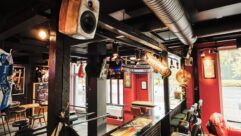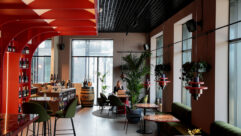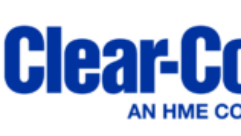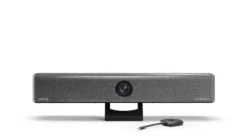
Religious Theater Raises The Bar
The new AV system in Trinity Broadcasting Network’s Miami Virtual Reality Theater creates a realistic experience for visitors.
Eustis, FL-based systems integrator RKRoden Show Systems used six Middle Atlantic WRK-44-32 equipment racks — three for audio, video, and control, and three for HD theater audio — in Trinity Broadcasting Network’s Miami Virtual Reality Theater. The top of each rack features a bulkhead connection to keep interconnecting wires organized.
CHALLENGE: To heighten the high-definition movie-watching experience in a 50-seat screening room without disturbing nearby operations.
SOLUTION: Design a custom AV system that improves upon a 10-year-old template consisting of various technologies, including a software-based digital audio processing system, low frequency transducers, 4,000-lumen projectors, and high-definition video servers.
FIVE YEARS before “The Passion of the Christ” transformed theaters across the country into temporary houses of worship for millions of moviegoers in search of cinematic salvation, “The Omega Code” proved faith-based films could draw a crowd. Without major studio backing or a marquee name above the title, the film about an Indiana Jones-like scripture sleuth in search of Biblical secrets raised many a Hollywood eyebrow by cracking the top 10 with $2.3 million in opening weekend receipts. Yet it wasn’t glowing reviews that drove churchgoers from their pews to the Cineplexes. Instead, it was a grassroots guerilla marketing campaign conducted by Santa Ana, CA-based Trinity Broadcasting Network (TBN), the Christian cable television station founded by Jan and Paul Crouch, that was responsible for the turnout.
Today, “The Omega Code” is one of five movies to unspool daily for much smaller — but no less rapturous — crowds at TBN’s recently completed Virtual Reality Theater (VRT) in Miami. The 50-seat screening room is the fourth such installation. The first was built nearly 10 years ago at TBN’s Trinity Music City location in Nashville, TN, and has played host to not only millions of visitors but several high-definition platforms. As a result, the Miami theater benefited from the first theater’s growing pains and incorporates a system with the storage capabilities and longevity to last.
Improving on the past
TBN’s Nashville theater may have been at the forefront of HD technology in 1995, but when Rick Roden considers the original system now, it seems antiquated. He has now worked on all four VRT projects, the first three as an independent contractor for an El Segundo, CA-based systems integrator. RKRoden Show Systems, the Eustis, FL-based company he co-founded in 1999 with his wife Kim, was the sole systems integrator on the Miami project. “The Nashville theater used pieces of hardware for audio processing,” he says. “Back in those days, Peavey MediaMatrix digital audio processing technology wasn’t available.”
The theater showed only one 50-minute movie at the time, and Brian Dugger, a digital video applications and development engineer for San Diego-based systems integrator TV Magic and former employee of TBN, says that was plenty for its AV system to handle. “Trinity was getting into HD before there was a standard to rely on,” he says.
The location relied on high-definition laser disc players to bring the movie to the screen, but the disks only held 15 minutes of content, meaning four units running in sequence would be necessary. “It was first generation,” Dugger says. “Between scenes they would have to dip to black, switch players, and then come back up.”
THE SILENT RUMBLE
Employees in the previous three Trinity Broadcasting Network (TBN) theater locations may have grown accustomed to the regularly scheduled rumblings caused by the movies’ loud subwoofer tracks, but the network wanted to do everything it could to eliminate that sound-bleeding nuisance in the Miami theater. So instead of relying only on a subwoofer to do the shaking, they turned to the Guitammer Company’s Buttkicker, which uses the same audio signal as a subwoofer to physically shake theater seats.
The low-frequency transducer, which is installed under each seat leg, has a 3.25-pound piston suspended inside the motor housing that responds to audio signals. And when powered by an amplifier, it produces vibrations that are transferred directly to the seat. “It uses a Class D amplifier because it needs more of a square wave instead of a sine wave for low frequency,” says Brian Dugger, a digital video applications and development engineer for San Diego-based systems integrator TV Magic and former employee of TBN.
As a result, TBN was able to use fewer dual 15-inch subs than were necessary in the other three locations yet still produce the same effect during earthquake scenes. Theatergoers get to feel the experience, and employees in neighboring spaces never know the difference. “We put the chairs on rubber isolators, so that when the audio track calls for a low-frequency rumble, it actually moves the seat pedestals and you feel it — literally — in the seat of your pants,” Dugger says.
As TBN added more movies to its roster, though, that arrangement became cost prohibitive. Over the next decade, the network moved from the WVHS compressed HD format to HDD5 servers and finally to an MPEG-2 HD player, Dugger says. By the time the Miami project was ramping up, the decision had been made to switch to QuVIS QuBit servers. TBN had expanded its roster of films considerably, and it needed a system that could store and play them back more efficiently. It also simplified the process of physically transferring the movies to the Miami location. Instead of going back to the masters to make copies, TBN was able to pull the hard drives out of its units in its Costa Mesa, CA, theater, copy them, and then send them down to Florida.
In addition, making the move to the new system made it possible to replace all of the hardware that had been required for audio processing with a software-based digital audio processing system. “By using Peavey’s digital audio MediaMatrix system, you have complete flexibility, you alleviate extra pieces of hardware, less wiring is required, and you gain more available equipment rack space,” Roden says.
The technological improvements extended to the video presentation as well. Projectors used in the previous three theaters were only capable of 700 lumens, but TBN upgraded to a Panasonic PT-D7600 DLP projector with closer to 4,000 lumens to bring high-definition video to the 18-foot-by-10-foot Stewart Filmscreen projection screen.
Perfecting the theater’s audio portion was an accomplishment in its own right. Like its three predecessors, the Miami location boasts 48 discrete channels, but it’s not a simple stereo recording split 48 ways. While filming its movies, TBN used a microphone array laid out similar to the theater’s speaker arrangement to produce a multi-channel recording. Dugger calls it Dolby Surround on steroids. “With Dolby Surround, phasing is used to trick your ears,” he says. “We don’t have to do that in this environment. We pretty much have a discrete channel and speaker in every location we want sound to come from.”
With that many individual tracks, precise audio syncing and proper mixing were major concerns. The QuBit server transmits linear time code to two 24-track Tascam MX-2424 24-bit audio recorders. The first handles the first 24 tracks, and the second, which is slaved, handles the second 24. For the mix, a Digidesign Pro Tools mix was set up in the theater, and TBN’s sound engineer listened to each track individually. “He could go through and post-produce in the theater itself,” Dugger says. “You can’t replicate this in a post-production environment. You need to actually be there in the main theater.”
That much audio in a relatively small space was both a blessing and a curse. TBN wanted a loud presentation to immerse crowds in sound, but it had created problems at the first three locations. In some cases, low-frequency audio for sound effects like earthquakes and cracks of thunder were so loud, they shook TBN’s offices and TV studios that shared the same building. “We’d have to put in four or five layers of drywall and insulation to try to contain all of that sound and prevent it from disturbing people in close proximity,” Dugger says.
With that in mind, they took proactive steps to prevent a repeat in the Miami location. First, they used low-frequency transducers that respond to audio signals and actually shake the theater seats to create a physical — instead of audible — sense of rumbling (see sidebar). Then they made some cuts in the concrete foundation. By cutting it loose from the rest of the foundation with a wet saw, they were able to reduce sound resonation through the rest of the building.
The devil in the details
For Roden, much of the project was a matter of paying attention to details. The system required six Middle Atlantic WRK-44-32 equipment racks: three for audio, video, and control, and three for HD theater audio. Roden designed and fabricated all six. Having seen numerous racks over the years that didn’t meet his standards, he put extra time into wire management at TBN’s theater in Miami. To keep the interconnecting wires organized, he installed a bulkhead connection on top of each rack. “Custom fabricated cables connect all of the equipment racks together at the top of each rack, so literally, if you unplug the racks on top, each one would roll right out and you could roll them away,” he says. “You roll them into a location, put your connections on top of the rack in minutes, and if you’ve got power, the entire system will be operational immediately.”
All show elements are controlled by Alcorn McBride devices such as the V16+ show controller and I/O64 discrete input/output expander. The lighting control was accomplished by utilizing the Alcorn McBride DMX Machine, which in turn drove an ETC SR48 dimming rack for all theatrical show lighting. The Alcorn McBride Digital Binloop was used for all audio playback throughout the VRT, other than the HD theater audio. This new system also incorporates the Alcorn McBride WEBster Internet interface device, which enables Roden to remotely control, monitor, or download any new programs to the show controllers from anywhere on the LAN or across the Internet.
FOR MORE INFORMATION
- Alcorn McBridewww.alcorn.com
- Digidesignwww.digidesign.com
- ETCwww.etcconnect.com
- Guitammer Companywww.thebuttkicker.com
- Middle Atlanticwww.middleatlantic.com
- Panasonicwww.panasonic.com
- Peaveywww.peavey.com
- QuVISwww.quvis.com
- Stewartwww.stewartfilm.com
- Tascamwww.tascam.com
Although the theater was built in an existing space, it had been gutted, so Roden also had a chance to start work with the installing electricians from the beginning to develop a proper isolated grounding system. He asked the electrical contractor for a dedicated power transformer and a dedicated sub-panel for all of his equipment. He also stipulated that all circuits in the field related to his system terminate back to the dedicated AV sub-panel. “The AC power feed to all equipment racks must use a nonmetallic flex,” Roden says. “A properly sized isolated ground wire is used to ground equipment racks. My emphasis on this standard practice alleviates a ground loop, which would result in undesirable audio hums, buzzes, or visible hum bars in video display units. It may seem elementary, but this never gets done properly on most installations.”
After the success of the installation in Miami, Roden already has more TBN work in his future: He’ll get a chance to replace all of the outdated equipment that still makes up the backbone of Trinity’s other locations, starting with the Costa Mesa location. “We’re upgrading them all,” Roden says. “We’re basically going to bring them up to spec with this one.”
Greg Matthews is a freelance writer based in Kansas City, MO. He can be reached at [email protected].










